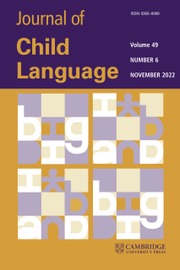Article contents
Subject, topic and Sesotho passive*
Published online by Cambridge University Press: 17 February 2009
Abstract
Counter to findings in English, German and Hebrew, recent acquisition studies have shown that the passive is acquired early in several non-Indo-European languages. In an attempt to explain this phenomenon, this paper addresses certain typological phenomena which influence the early acquisition of passives in Sesotho, a southern Bantu language. After outlining the structure of the Sesotho passive and its syntactic and discourse functions, I examine Sesotho-speaking children's spontaneous use of passives, showing that the acquisition of passives in Sesotho is closely linked to the fact that Sesotho subjects must be discourse topics. I conclude that a detailed examination of how passive constructions interact with other components of a given linguistic system is critical for developing a coherent and universally applicable theory of how passives are acquired.
Information
- Type
- Articles
- Information
- Copyright
- Copyright © Cambridge University Press 1990
Footnotes
Data for this paper were collected in Lesotho and were supported by Fulbright-Hays and Social Science Research Council doctoral dissertation research grants. Preliminary preparation of this paper was conducted with support of NICHD Developmental Training Grant 5T32 HD07181, administered through the University of California at Berkeley. An earlier version of this paper was presented at the Child Development Conference, Boston University, in October 1985. I thank Ruth Berman, Melissa Bowerman, Nancy Budwig, Eve Clark, Mark Johnson, Henriette Lempert, 'Malillo Machobane, Michael Maratsos, Salikoko Mufwene, Steven Pinker, Dan Slobin, Robert Van Valin and Kenneth Wexler for discussion, comments and suggestions. The final interpretations, however, remain my own.
References
REFERENCES
- 46
- Cited by

